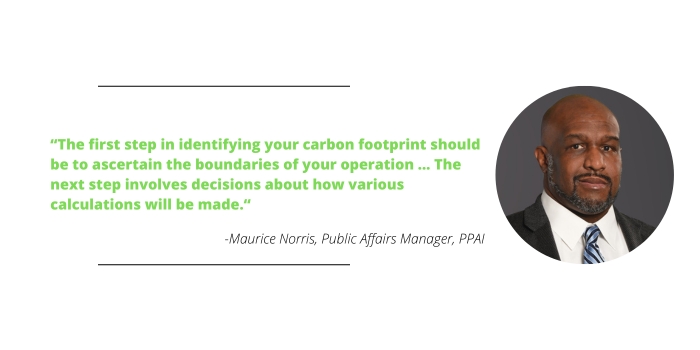Greener By The Numbers

As organizations implement sustainability initiatives, it is important to track their progress, success and impact. As famed management consultant Peter Drucker is credited with saying, you can’t improve what you don’t measure.
Where To Get Started
Several tools are available to determine a company’s carbon footprint. The Greenhouse Gas Protocol has free training sessions on its website, and its guidance is divided into calculating the various levels of emissions: Scope 1, 2 and 3.
- The Environmental Protection Agency describes Scope 1 emissions as generated from sources that are controlled or owned by an organization, for example, emissions associated with company-owned vehicles or furnaces.
- The EPA describes Scope 2 emissions as those that are associated with the purchase of electricity, heat, steam or cooling. Even though the energy is not generated at the company’s location, Scope 2 emissions are the result of an organization’s energy use, so they are accounted for as part of that organization’s GHG calculations.
- Scope 3 emissions are defined by the EPA as the result of activities from assets that are not owned or controlled by the reporting company but that the company indirectly affects in its value chains.
In 2022, the U.S. Securities and Exchange Commission proposed a rule to update required climate-related disclosures. This presents implications beyond large or publicly traded companies, as it requires those companies to delve into their supply chains, which often include promotional products businesses. Scope 3 emissions are an example of how although not all promo companies will be directly affected by the SEC’s proposed disclosure regulations, many industry members’ clients will be required to obtain relevant information from them.
The first step in identifying your carbon footprint should be to ascertain the boundaries of your operation, specifically what items your company owns or holds investments in. This refers to buildings, vehicles and equipment.
The next step involves decisions about how various calculations will be made. Depending on which carbon tracking tool a company decides to use, it may have the option to measure its carbon emissions based on either operational control or financial control:
- Choosing operational control to measure carbon emissions means the company will need to consider those entities within the boundary that was determined in step one. These are items the company has operational control over and are managing as a normal part of their business.
- Choosing financial control means the company is also going to be accounting for anything they might have investments in, even if those invested entities have their own management.
Important parts of this decision include being as complete and accurate as possible and making a choice that can be sustained long-term, because year-over-year consistency is critical to measuring the company’s efforts.
After these initial determinations, logistical endeavors can begin, such as figuring out who has access to the company’s utility bills and who has the relevant data for the needed calculations. These details include everything within the company’s boundaries that were outlined in step one. This information will enable the next step of beginning to calculate the company’s usage information applicable under Scope 1 and Scope 2 emissions. The EPA provides a GHG Emissions Calculator, updated in 2022, to help small businesses estimate their annual GHG emissions.

How To Develop KPIs
While the Greenhouse Gas Protocol is a useful instrument to measure carbon emissions, the Global Reporting Initiative is a widely used tool for determining key performance indicators. It outlines the process for determining which issues are material to a company, such as items the company has direct control over or things it can directly impact within the environmental, social and governance categories.
The GRI lists a variety of metrics for companies to report, including the percentage of reclaimed materials a company uses in its products and the number of training sessions a company provides for its employees, among other things. One industry distributor created an employee group to periodically report internally on electricity and gas usage, as well as waste pickup and recycling rates. Other reporting concerns relate to supply chains, like the frequency of audits and the percentage of product offerings that could include any sustainability attributes.
Setting Goals And Science-Based Targets
In partnership with the UN Global Compact and other organizations, the Science Based Targets initiative provides companies with a defined pathway outlining how they can help meet their goals. The initiative considers companies’ size and emissions impact to determine actions tailored to their current abilities and projected growth.
SBTi provides guidance on setting an appropriate target, and once the company commits, it has 24 months to set it. The company submits its target and supporting documents to SBTi, and upon receipt, the initiative reviews the materials to ensure that the target aligns with their requirements, offers feedback and asks any clarifying questions before approval. After approval, the company is obliged to report annually on its progress, as well as to revisit the target every two years with considerations for how the business has grown or changed and to ensure the goal is still valid.
It is important to remember that sustainability initiatives are moving targets.
Carbon Offsets And Renewable Energy Certificates
Carbon-neutral claims, whether regarding a company’s processes or products, are typically supported by purchasing carbon offsets. The emissions still exist, but the offset generates a balancing project elsewhere that neutralizes the impact of the activity for which it was purchased. Carbon offsets typically cannot be used as part of a science-based targets program because offsets must support activities that are outside the normal course of business.
Renewable energy certificates are tradable energy credits in the U.S. that represent 1 MWh of electricity generated from an eligible renewable energy resource and fed into the shared system of power. RECs can be used as part of a company’s science-based target commitment because they involve activities that fall within the normal course of business. Examples include installing solar panels or purchasing equivalent numbers of RECs from the utility provider to cover energy usage.
One does not need to be an expert in this area to make a meaningful impact. However, it is important to record and measure any efforts that are made to learn and improve.
Norris is PPAI’s public affairs manager.

